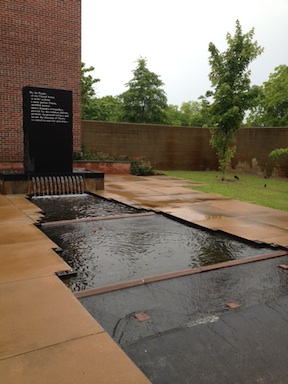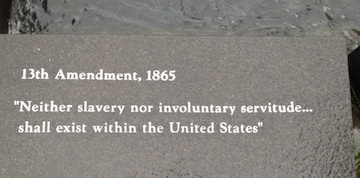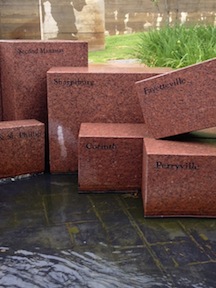Day Four: The Stream of American History
Because Dan is working on a book about Corinth, for the Emerging Civil War Series, the town is a “must” on our tour. While I’ll help him grab some photos for the book, my main interest in returning to Corinth comes from an entirely different angle.
I’ve spent a lot of time at ECW talking about the relationship between history and art, usually in the form of novels or movies, but here at Corinth is one of the most provocative interminglings of the two.
The NPS’s Civil War Interpretive Center, which opened in 2004, offers information about the siege of Corinth in the spring of 1862 and the battle of Corinth in the fall of that same year. There’s also information about the town’s “Contraband Camp.” As part of Shiloh National Military Park, the center also offers information about that battle, as well. It’s a beautiful, polished visitation experience well worth the stop.
In a courtyard behind the building, the NPS offers a wonderfully contemplative experience: The Stream of American History, 1770-1870. Part fountain, part sculpture, it offers a visual representation of the birth and growth of the United States, increasing sectionalism, and Civil War.
 “Beyond its inviting, initial emotional appeal, and with a complexity at first glance easily overlooked,” a Park Service brochure says, “this watercourse records the flow of events central to understanding the American nation’s turbulent first century.”
“Beyond its inviting, initial emotional appeal, and with a complexity at first glance easily overlooked,” a Park Service brochure says, “this watercourse records the flow of events central to understanding the American nation’s turbulent first century.”
As I talk about the monument, I’ll move from left to right. That’s important because the flow of water and time are tied together in the memorial, so knowing which way both are flowing is important in understanding how this all fits together.
At one end of the courtyard, a black granite monolith rises from a pool of water. On the side facing away from the rest of the memorial: Thomas Jefferson’s evocative words from the Declaration of Independence: “We hold these Truths to be self-evident . . . all men are created equal….”
“Left unsaid,” says the Park Service brochure, “is the contradictory reality existing when Jefferson penned this inspiring theory of government.” Many critics of slavery in the republic’s earliest year pointed out the hypocrisy of fighting for liberty even as some Americans denied their slaves that same right.
The flip side of the monolith features the preamble of the Constitution. Note that as we go from left to right, time moves in that direction, too. So, the Declaration came first, then the Constitution.
 Thirteen notches, representing the thirteen colonies, allow water to pass from the pool into a narrow spillway. Beyond that point, which represents 1790, every three and half inches the water travels represents a year of time.
Thirteen notches, representing the thirteen colonies, allow water to pass from the pool into a narrow spillway. Beyond that point, which represents 1790, every three and half inches the water travels represents a year of time.
Along the way, small fountainheads—each representing a new state—add water to the flow. New northern states are on the far side of the stream; southern states on the near side. The spillway widens to accommodate the additional flow and also visually represent the nation’s growth in geography and population.
At 1820, the spillway flows over a lip that represents the Missouri Compromise. A little farther down, the stream flows over the Compromise of 1850. Scattered between are other small blocks that represent smaller obstacles—creating more ripples—in the flow. The blocks are located in positions that correspond to each state (although that’s impossible to know without the Park Service’s handy-dandy guide).
 When the water reaches 1860, the scale of the memorial changes. A huge row of fifty-two “battle blocks” divides the stream. “The watercourse is now fast moving, energetic, and irregular shaped,” the brochure says.
When the water reaches 1860, the scale of the memorial changes. A huge row of fifty-two “battle blocks” divides the stream. “The watercourse is now fast moving, energetic, and irregular shaped,” the brochure says.
Each block bears the name of a battle or campaign, with campaign names inscribed in ALL CAPS. Battles fought in the Eastern Theater appear on the east side of the memorial; Western battles appear on the west side. “Battles commonly known by different names in the north and south have both been inscribed,” the brochure says, “with each visible only from opposite sides of the stream.”
 The curve of the stones toward the Southern side of the spillway suggest early Confederate success, but after 1862, the flow straightens. After Appomattox, the two sides of the stream come together again and then flows through a bridge that highlights the thirteenth, fourteenth, and fifteenth amendments.
The curve of the stones toward the Southern side of the spillway suggest early Confederate success, but after 1862, the flow straightens. After Appomattox, the two sides of the stream come together again and then flows through a bridge that highlights the thirteenth, fourteenth, and fifteenth amendments.
Beyond, a still pool allows for reflection. Beneath the surface, an inscription reads “The Civil War was fought over issues of liberty. The cost was high and many issues remain to be resolved.”
While the statement is true, it’s a total dodge of the slavery issue—but a reflection of the early 2000s, when the Park Service made an effort to avoid controversy. It wasn’t until heading into the sesquicentennial before the NPS finally decided to fully embrace slavery as the cause of the war, and some places still deal with it more gingerly than others. This is the most ginger handling of it I’ve yet seen.
 Another block invites further reflection: “ The United States as we know it today began not with the Revolution of 1776 but rather in the new nation that emerged from the Civil War.” That reminds me of the old point that prior to the Civil War, people said “The United States are…” but today we say “The United States is….” We’re now singular instead of plural.
Another block invites further reflection: “ The United States as we know it today began not with the Revolution of 1776 but rather in the new nation that emerged from the Civil War.” That reminds me of the old point that prior to the Civil War, people said “The United States are…” but today we say “The United States is….” We’re now singular instead of plural.
Overall, there is a lot happening in this plaza. Much of it is subtle – perhaps too subtle for most people to even notice. For me, though, that kind of depth and richness makes the memorial something worth visiting over and over. There is always something new to discover and appreciate and think about. It can continue to be provocative and contemplative, which is a hallmark of good art.
But even for those who don’t pick up on the memorial’s many levels, it is still cool and interesting to look at. That, too, makes it good art.
Does this particular art help us better understand history? I’m not sure, but it certainly gives us a new way to think about it. And that, I think, makes it great.

The NPS’s Civil War Interpretative Center at Corinth is one of the most comprehensive museums concerning the history of our Country. A visit to Corinth for the Civil War sites Is a must, but visiting the Center is essential. Thanks for highlighting one of the NPS’s outstanding sites. I look forward to the book on Corinth.
It is impressive how much they pack into that little place!
I think the monument is excellent and saying the war was over Liberty I think does deal with the slavery issue. As a monument, it is not like an interpretive marker or museum exhibit where a lot of text and explanation is provided (thus your brochure). It is thematic and allows the visitor to think on their own. Which I for one, think is a great thing…too often recently NPS sites don’t want visitors to think for their own, they want to tell people what they should think. A true mistake in interpretation. Enjoy Corinth…a great place to visit
But that suggests that slavery as the cause of the war is a matter of interpretation, and it isn’t.
I do agree that some parks have pushed it too hard relative to their respective missions (people generally come to battlefields because of the battles, not for an overview of the whole war). However, that’s a question of dosage, not of truth.
But that suggests that everyone agrees with the causes of the war. Being a Federal govt site, paid for by everyone (even those who are on the fringe) they have the responsibility to give ALL view points. You (and I ) I don’t think slavery is a cause is not a matter of interpretation, but many people do. And being a national site requires them to provide the facts and information and allow the visitor to interpret that information. Something I think Corinth does very well (the do include the 13th Amendment and other items relating to the end of slavery). But again…its a monument, not an interpretive panel or museum exhibit.
Part of the problem is the rhetoric itself. A statement like “slavery was the cause of the Civil War” seems like a straightforward fact because the evidence supporting it is so overwhelming. Too often, I suppose, people leave it at that – which also leaves the door open for people to contest it as though the cause of the war is a matter open for interpretation even though it’s not. “States rights,” for instance, is not an alternative interpretation–because the specific right the south was arguing over was the right to own slaves. There were other “states rights” issues too, but I have yet to hear a “states rights” argument that didn’t have slavery tucked away at its core.
Historians – and public historians, in particular – need to better clarify that direct link when they(we) say things like “Slavery caused the war.”
In that context, Corinth’s use of “liberty” is just as guilty of over-generality, and I honed in on it, I’m sure, because for so long, too many people were afraid to discuss slavery head-on, and I saw that as just such an instance. But until we can discuss such things openly, we’ll never solve any of the race issues we still have in America, which is why I feel so strongly about it.
I concur about Corinth, and the water sculpture. I also really like the approach path, walking up the ramp with the embedded battlefield discards.
That approach to the interpretive center is evocative in the best sorts of ways.